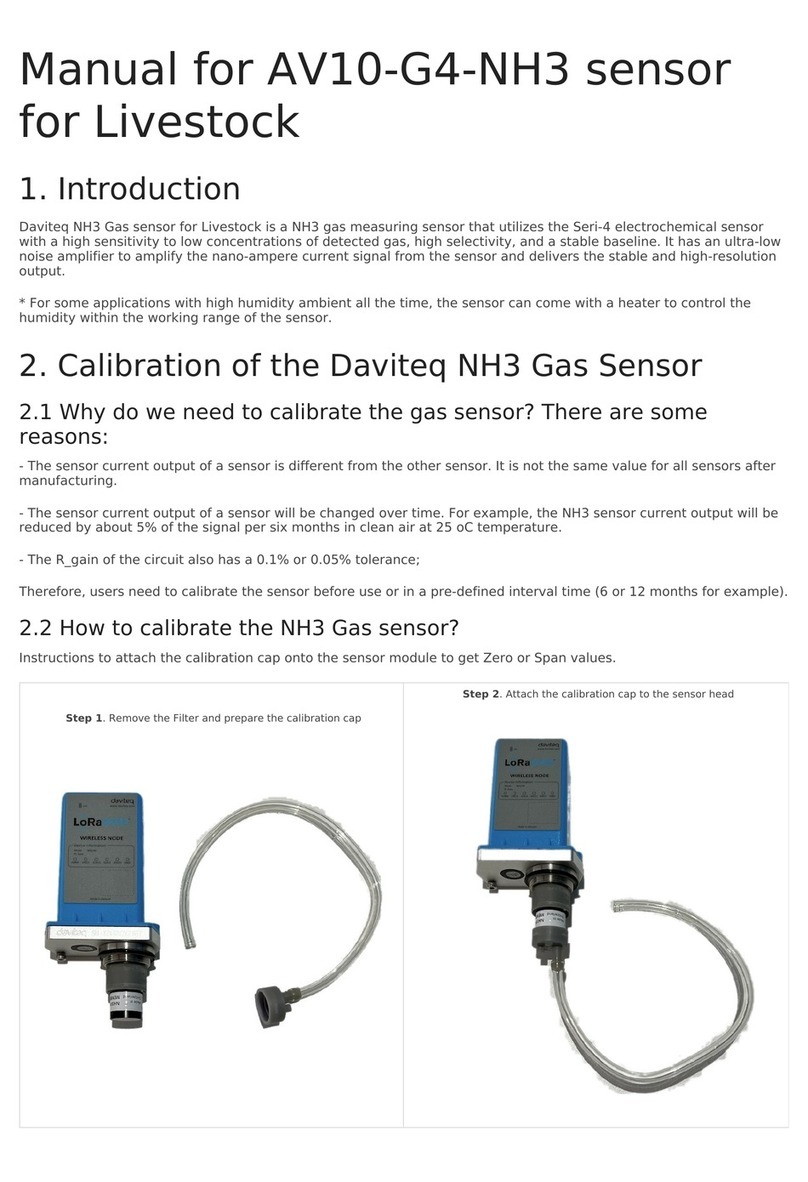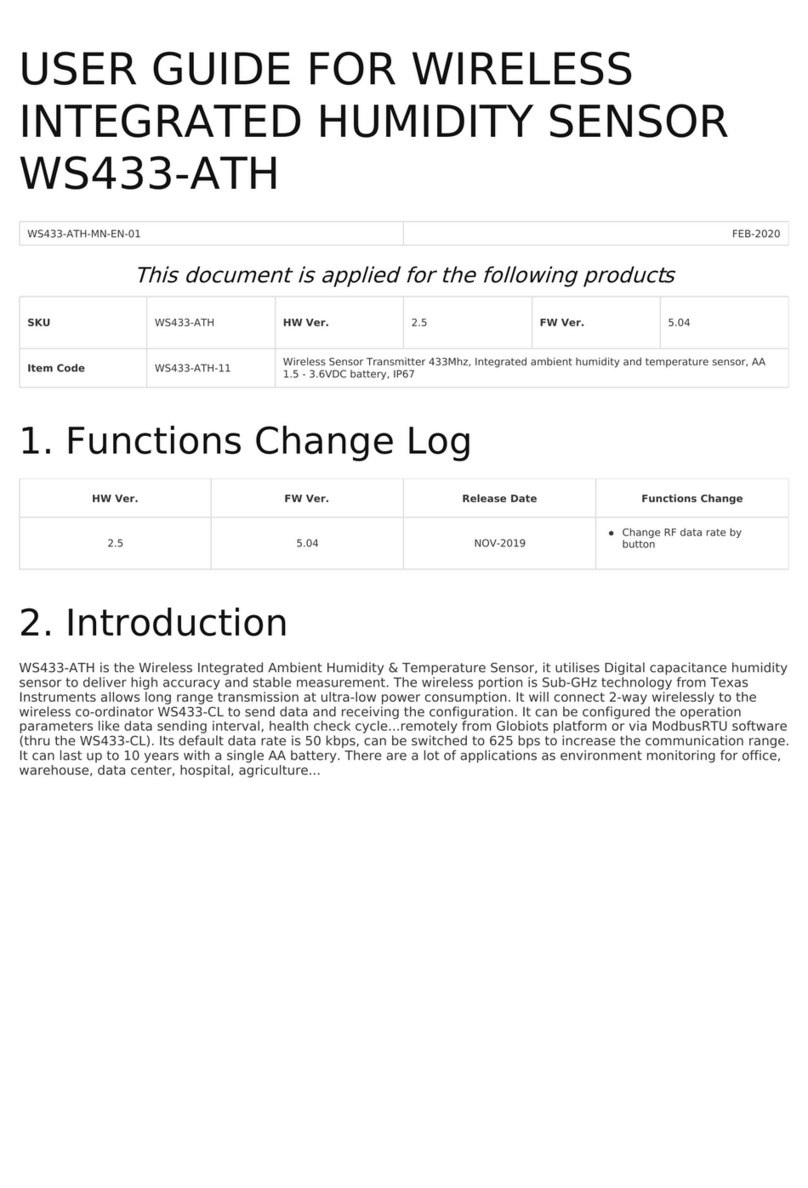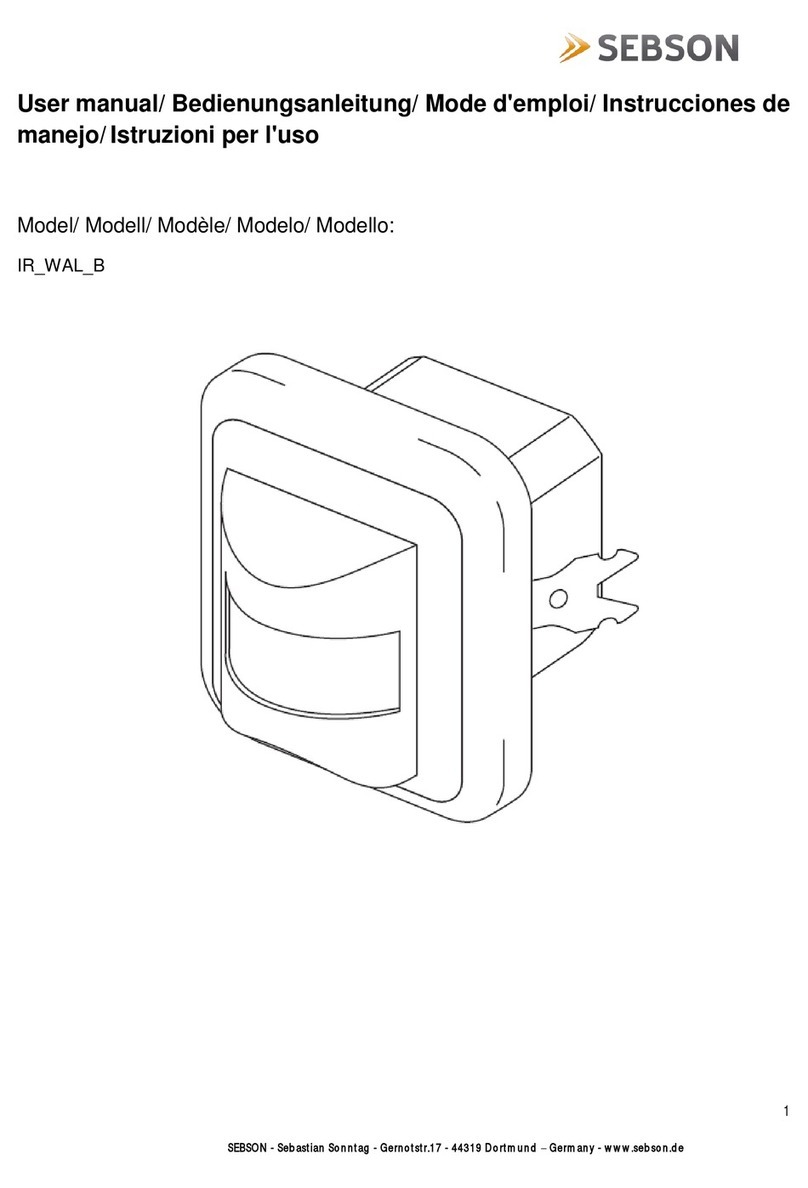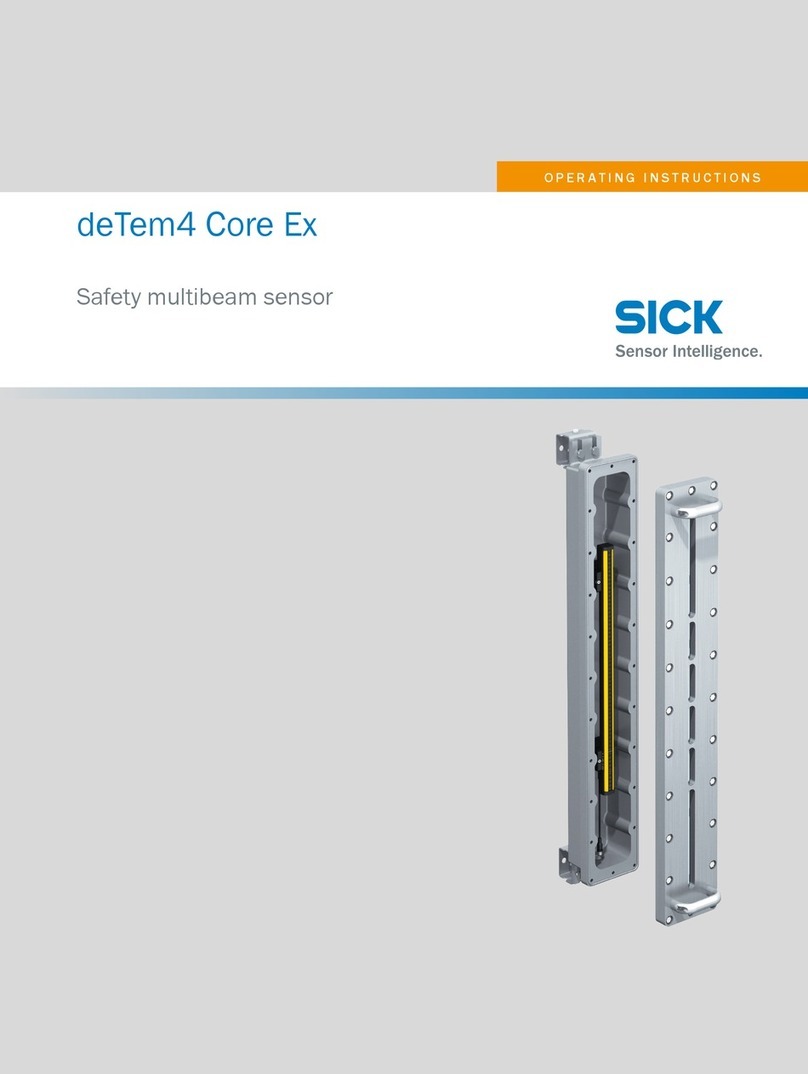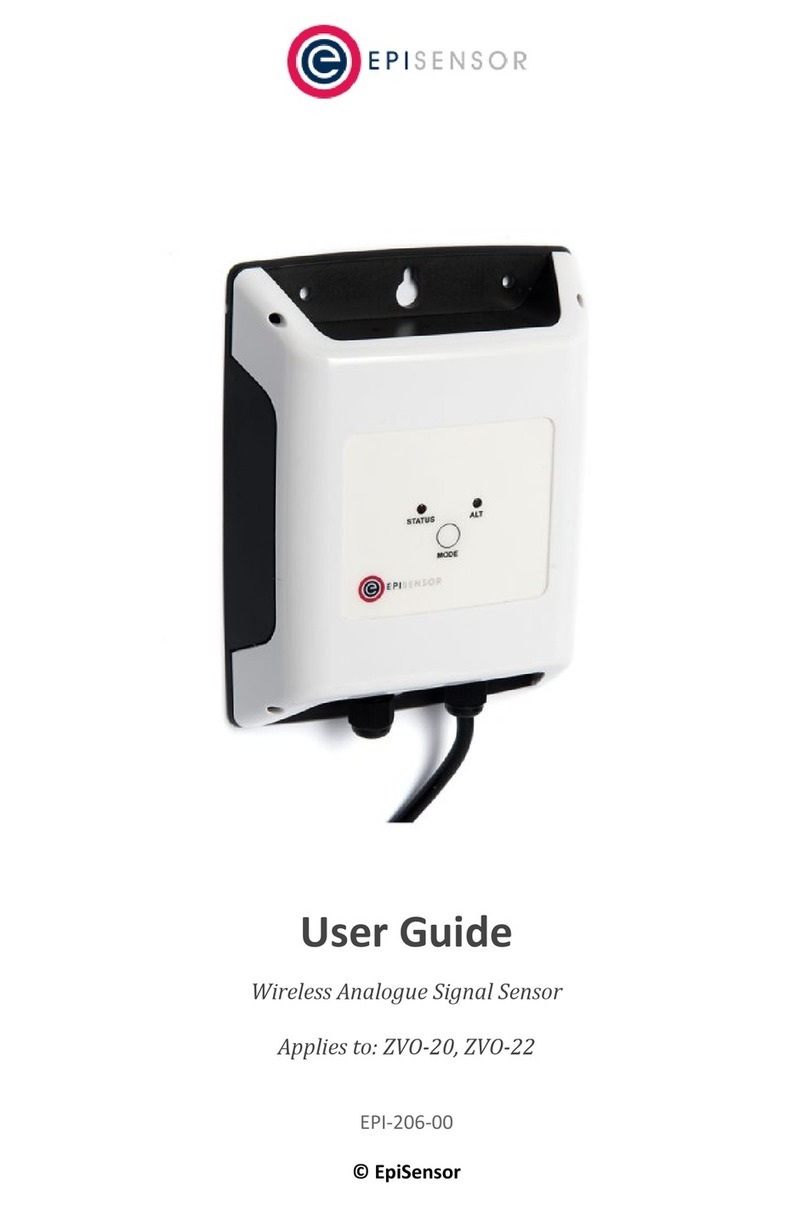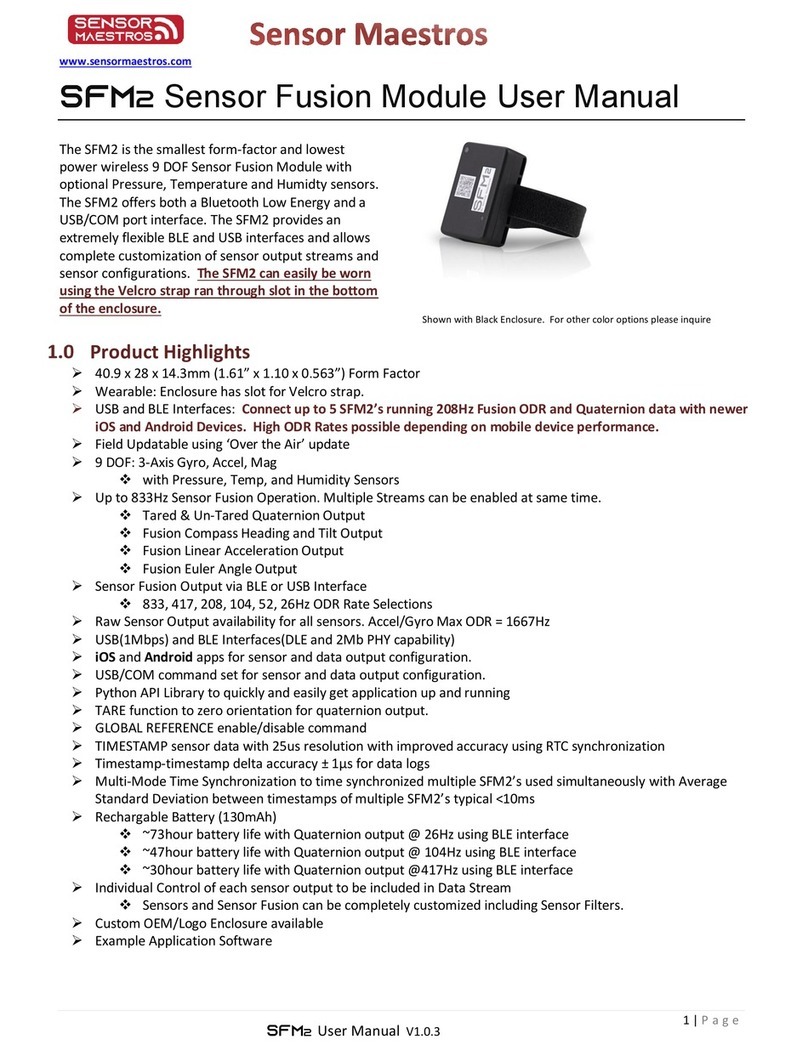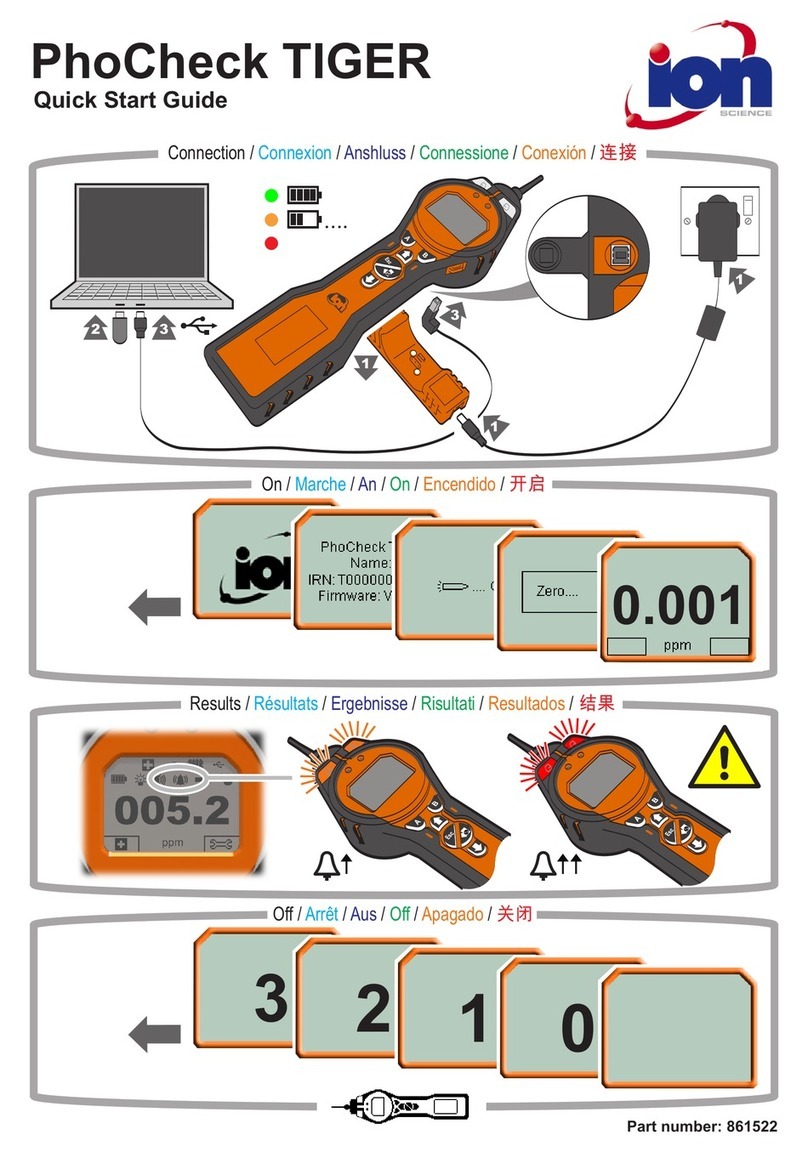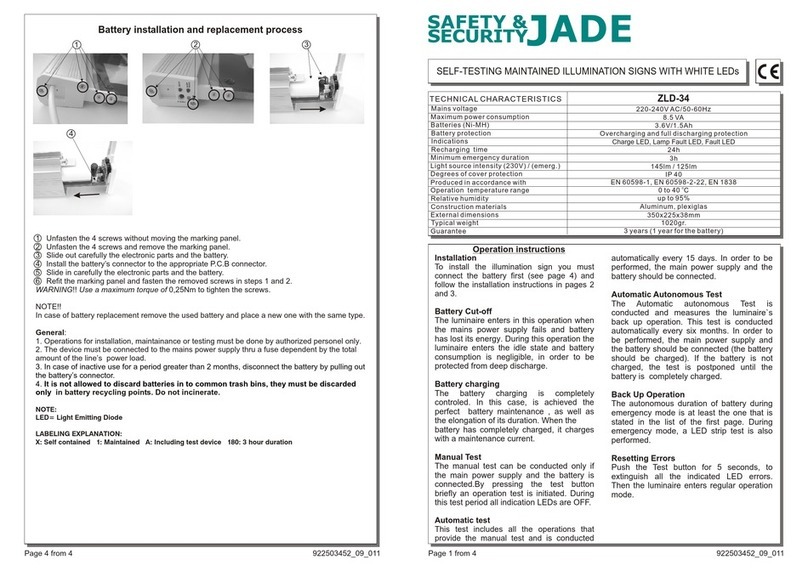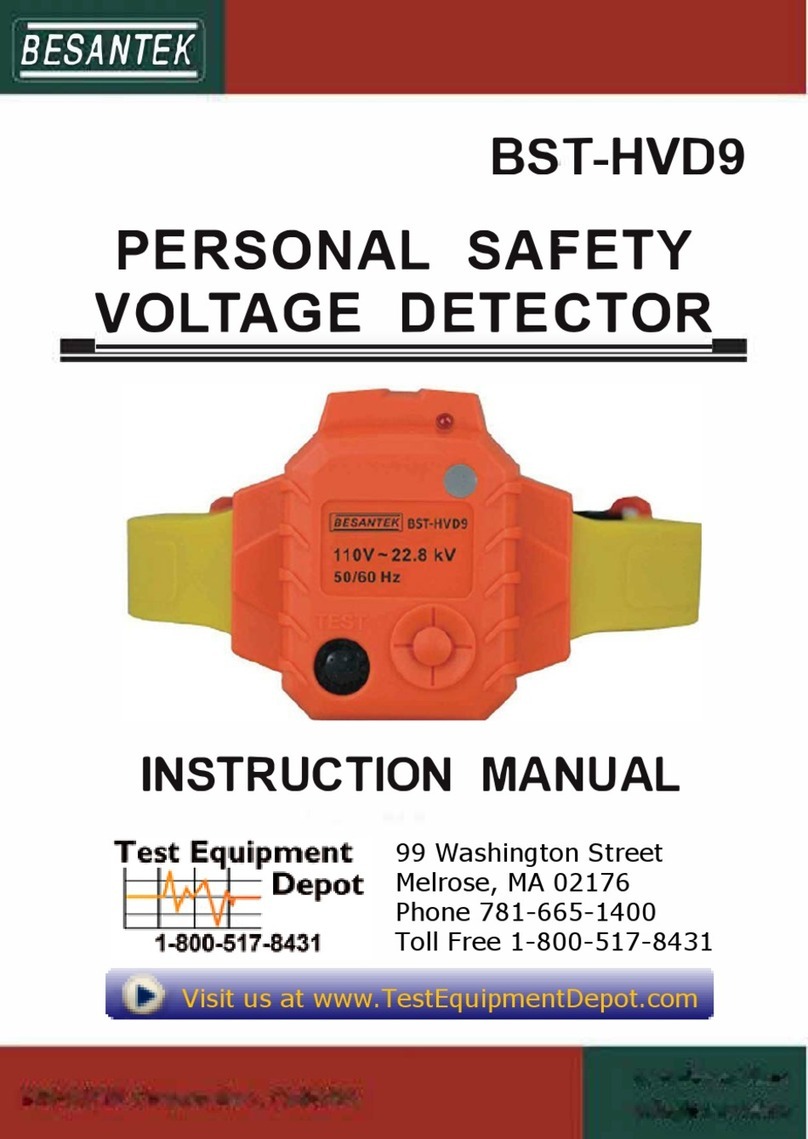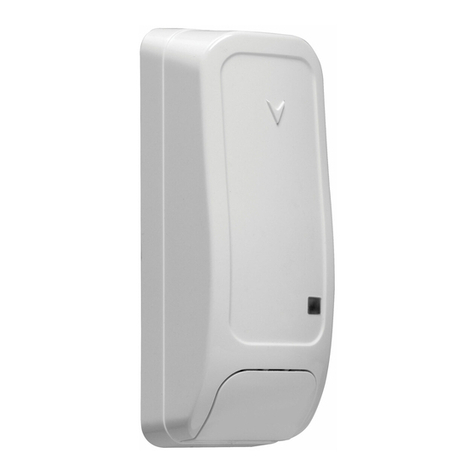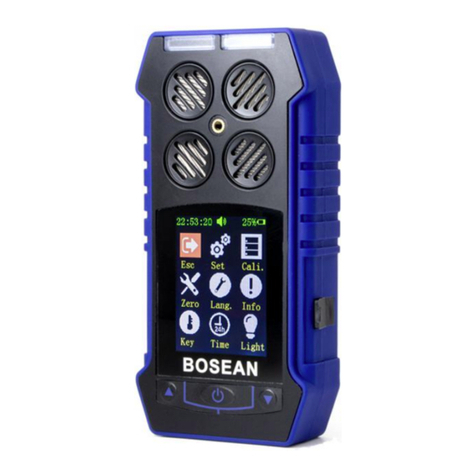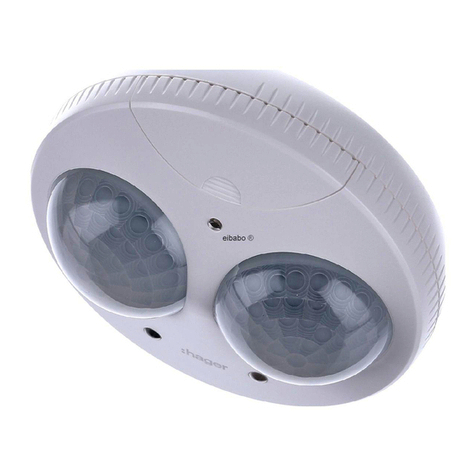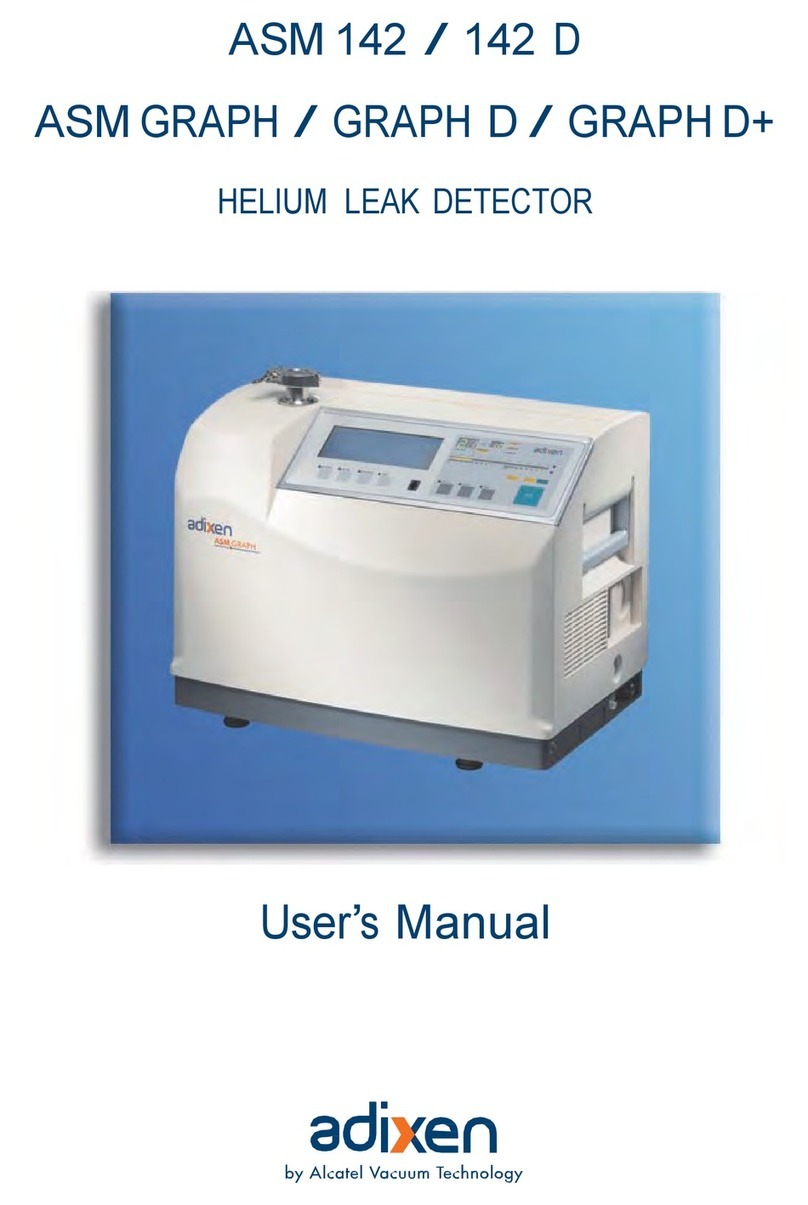daviteq Sigfox WSSFC-AC FW1 User manual

Sigfox Sensors - Type 2 are Tilt sensor, Soil moisture, Humidity... the sensor with Blue box housing.
Manual for Sigfox-Ready AC Current Sensor - WSSFC-AC | FW1
Manual for Sigfox-Ready Air/Gas Flow Sensor - WSSFC-M12F-AFD | FW1
Manual for Sigfox-Ready Single-Axis Vibration Sensor - WSSFC-V1A | FW2
Manual for Sigfox-Ready AC Current Sensor - WSSFC-AC | FW3
Manual for Sigfox-Ready Single-Axis Vibration Sensor - WSSFC-V1A | FW3
Manual for Sigfox
Sensors - Type 2

Thank you very much for choosing Daviteq Wireless Sensors. We are the leading wireless sensor manufacturer in the
World. We have a wide range of wireless sensors which support different connectivity like LoRaWAN, Sigfox, Sub-GHz,
NB-IoT...Please find out more information at this link.
This manual is applied to the following products
Item code
HW Version
Firmware Version
Remarks
WSSFC-AC-11
1.0
1.0
Information Changes in this version v.s previous version
Item
Changes
Changed by
Changed Date
Approved by
Approved Date
1
Initial version
D.Q.Tuan
09-04-2022
N.V.Loc
28-06-2022
To use this product, please refer step by step to the below instructions.
Operating Principle
Uplink Payload
Battery
Connect to Sigfox Network
Installation
Troubleshooting
Configuration
Calibration
Specification
Warranty and Support
Manual for Sigfox-Ready AC
Current Sensor - WSSFC-AC | FW1
1. Quick Guide
Reading time: 10 minutes
Finish this part so you can understand and put the sensor in operation with the default configuration from the
factory.
1.1 What is the Sigfox-Ready AC Current Sensor and its
principle of operation?

WSSFC-AC is a Sigfox-Ready sensor with an integrated AC current measuring transducer that can measure the AC
current from a current transformer with max 5A AC current. It is compatible with any brand of current transformer (CT)
on the market which gives an output max of 5A AC. The CT ratio will be selected based on the load current.
It is battery-operated and able to connect to any Sigfox network in the World. It supports all frequency zones such as
RC1, RC2, RC3c, RC4, RC5, RC6, and RC7.
For the principle operation of the AC current sensor, please refer to this link.
Please refer to this link for typical applications.
The device will send uplink messages in the following cases:
Case 1: After power-up in the 60s, the device will send the first message called START_UP. The payload will tell
the user the HW version, FW version, and current configuration of the device;
Case 2: Then, in every interval time (pre-configured), for example, 10 minutes, it will send the message called
CYCLIC_DATA. The payload will tell the user the following data like measured value (AC current value), battery
level, alarm status...
Case 3: In case the Alarm function was enabled (in the configuration of the sensor), if the measured value
passed the threshold, it will send the uplink message immediately. This message is called ALARM. The payload
also tells the user the data like measured value (AC current value), battery level, alarm status...
Case 4: The HEART_BEAT uplink message will be sent once a day (the default setting, can be changed in
configuration) to allow the Sigfox back-end system can send the downlink message for changing the
configuration of the sensor. Please refer to the downlink section for more details. The uplink payload will tell the
user the HW version, FW version, and current configuration of the device;
Case 5: During commissioning, testing, or calibration sensor, the user can force the device to send the uplink
message so that they can get the data immediately. This message is called FORCE_DATA. The payload will
provide data like raw measured value, scaled measured value, battery level, alarm status... It can be forced by
applying the magnet key on the reed switch in 1s;
Case 6: In case users want to change the configuration immediately, they don't need to wait up to 1 day for the
HEART_BEAT message, instead they can force the device to send a special uplink message so that the device can
get the new downlink message. This uplink message is named PARAMETERS_UPDATE. It can be forced by
applying the magnet key in more than 5s.
The sensor was pre-configured at the factory with default values for configuration parameters that meet the most use
cases. However, depending on the specific use case, the customer can adjust those parameters. Please refer to
section 3.2 for more details.
The sensor is powered by 2 x AA 1.5V batteries for many years of operation. We do recommend using Energizer L91
battery which is very popular and high performance. This battery has a capacity of up to 3500mAh with a working
temperature range from -40 to +60 oC. The instruction for installing the batteries is in this link.
For Battery life estimation, please refer to this link.
1.1.1 What are the typical applications of this sensor?
1.1.2 When does the device send uplink messages?
To change the cycle of data sending, you can change the value of the parameter: CYCLIC_DATA_PERIOD (default
is 600 seconds).
The alarm thresholds can be changed via downlink or offline tools.
1.1.3 The important configuration parameters
1.1.4 What kind of battery is used for this sensor?

With the default configuration, the device can be connected quickly to the Sigfox Network by the following steps.
Device ID
Get Devive ID on the device nameplate
Device PAC
Get Devive PAC on the device nameplate
Please refer to this link for details
Please refer to this link for instructions on battery installation.
1.2 What's in the package?
The package includes:
01 x Main device
01 x AC current measuring transducer M12 and cable
01 x Magnet key
01 x Wall mounting bracket and screws
1.3 Quick Test
Step 1: Prepare the values of communication settings:
Note: All Sigfox sensors are pre-configured with the correct RC before delivery. The settings of Device ID,
Device PAC, and RC could be also read from the device memory map. Please reference section 3.2 Sensor
configuration for details.
Step 2: Add the device to Sigfox Backend
Step 3: Install the batteries to the device
After installing the battery in 60 seconds, the first data packet will be sent to the Sigfox network. After receiving

Please refer to section 1.4 Uplink Payload and Data Decoding for details of decoding the receiving packet to get
the measured values.
For the Uplink Payload structure, please refer to this link.
the first data packet, the time of another packet depends on the value of the parameter:
CYCLIC_DATA_PERIOD. Additionally, you can use a Magnet Key to force the device to send data instantly.
Step 4: Decode the payload of receiving package
1.4 Uplink Payload and Data Decoding
Note: Please select the right Payload document to suit the FW version of the sensor
1.5 Sensor Installation
SAFETY ATTENTION:
- TO REPLACE BATTERIES OR SERVICE THE MAIN DEVICE, PLEASE PAY ATTENTION TO THE ELECTRICAL SHOCK
THAT MAY HAPPEN DUE TO THE PROBLEM OF THE AC CURRENT CABLE OR FAILURE OF THE CURRENT
TRANSFORMER. FOR SAFETY REASONS, REMOVE THE AC CURRENT TRANSDUCER OUT OF THE MAIN DEVICE BY
UN-SCREWING THE M12 CONNECTOR BEFORE OPENING THE PLASTIC HOUSING OF THE MAIN DEVICE;
- ONLY QUALIFIED ELECTRICAL TECHNICIANS CAN HANDLE THIS DEVICE FOR INSTALLATION, MAINTENANCE,
AND OPERATION;
- USE THE HEAT-SHRINK PVC TUBE TO PROTECT THE CONNECTIONS ON THE CABLE OF THE AC CURRENT AND
AVOID THE WATER CONTACT WITH THOSE ELECTRICAL CONNECTIONS.
DIMENSIONS OF PRODUCT

The Sigfox-Ready AC current sensor is a combination of a wireless transmitter and an AC current transducer.
Therefore, the installation will be divided into 02 parts:
Installation for the wireless transmitter: these steps are to make sure the device sends data successfully;
Installation for AC current circuit: these steps are to make sure the device to measure correctly.
Locate the place to mount the CT, the place that is to measure the load current;
Locate the place to mount the Wireless transmitter to get the best RF signal. As the AC current transducer will be
attached to the wireless transmitter, please make sure the cable length is enough for the distance from CT to the
wireless transmitter;
Mount the wireless transmitter on the wall or outside the wall of the electrical panel. The antenna part must be
higher than the highest point of the electrical panel. Then connect the grounding wire from the base of the
wireless transmitter (if available) to the grounding system of the facility. Please check this link for the mounting
Please follow the orders of steps strictly as below.
1.5.1 Preparation of the locations
To get a strong RF signal please refer to this link.
1.5.2 Wireless Transmitter Installation

guide;
Insert the batteries into the wireless transmitter and check the system to see whether the wireless transmitter
already sent the first message to the system? Please follow this link to know how to install the batteries.
For closed-type CT, please shut down the main load before installing the CT.
For clamp-type CT, it is possible to install the CT onto the load wire, however, we highly recommend shutting
down the main load for safety reasons.
Use the crimping tool to make the connection and protect the connection with a PVC heat shrink tube as this link.
Connect the AC transducer to the wireless transmitter via the M12 connector as this link.
The Sigfox-Ready AC current transducer is produced with accuracy as published in the specification of the product
and is ready to use. However, the user can re-calibrate the sensor again when necessary, please follow the steps in
this link.
After connecting, the sensor will send the data to the system with the value = zero (no AC current). Then you can turn
ON the main load again to put the system into the operation.
You can use a clamp-type ampere meter to validate the value reading from the system. Please make sure the two
comparison values must be collected at the same time.
Problems with Sigfox communication like not receiving the packets...please refer to this link to troubleshoot
the device.
Problems with the sensor functions like not measuring, or inaccurate measuring....please refer to this link to
troubleshoot the sensor part.
Maintenance works
Yes/No
Descriptions
Consumable parts replacement
No
The Sigfox-Ready AC current sensor has no consumable
part, so there is no need to replace any parts.
Cleaning sensor or device
No
ATTENTION:
REVERSED POLARITY OF BATTERIES IN 10 SECONDS CAN DAMAGE THE SENSOR CIRCUIT!!!
1.5.3 CT Installation
Shut down the main load before installing the CT
Danger: be aware of electrical shock with AC voltage!
1.5.4 Connect the CT with the AC current transducer
1.5.5 Connect the AC transducer to Wireless Transmitter
1.5.6 Device calibration
1.5.7 Turn on the Main load again
2. Maintenance
2.1 Troubleshooting
2.2 Sensor maintenance

Re-calibration / Re-validation
Yes
The transducer may need to be re-calibrated when
necessary. Please refer to this link for the procedure of
calibration.
The Daviteq Sigfox-Ready AC current sensor comprises 02 parts connected together as shown below picture.
- The Daviteq Sigfox-Ready wireless transmitter;
- The Daviteq AC 5A current Transducer;
The AC current transducer is to measure the actual AC current of the secondary winding of the CT.
The Sigfox-Ready is to read the AC current value from the transducer and perform the scaling (A and B values, during
calibration). The scaled current will be multiplied by the CT ratio to deliver the final value which is the actual load
current that the user wants to measure.
Scaled_CT_Current = A x CT_Current + B
Actual_Load_Current = Scaled_CT_Current x CT
Where:
A : Constant A
B : Constant B
CT_current: the measured current from the transducer (Secondary winding current of the CT)
3. Advanced Guide
3.1 Operating principle of the Sigfox-Ready AC current sensor
3.1.1 Operating principle of the complete device
For example: the CT_current = 1.5A, the CT ratio = 20 (the CT is 100/5), A=1, B=0 ==> then the
Actual_Load_Current = 1.5 x 20 = 30A
Note: the Low cut value of Actual_Load_Current is 0.5A. That meant the device can not measure the current
load less than 0.5A

To understand how the AC current transducer can measure AC current, please refer to this link for a complete
understanding of this measuring technique.
Below are some important configuration parameters which affect the operation of the device like battery life,
measurement accuracy, and alert threshold.
For Battery life estimation, please refer to this link.
measure_period | Default = 600s
This is the time period for the wireless transmitter to wake up and take the measurement from the transducer.
The default value is 600s. Users can reduce this value, but smaller value, shorter battery life!
cyclic_data_period | Default = 600s
Interval time to send an uplink message regardless of any conditions
sensor_boot_time | Default = 1000mS
This value will affect the measurement accuracy. DO NOT change this value!
Those configuration parameters can be changed by downlink or offline tools. For more other configuration parameters,
please refer to the next section.
Sensor configuration can be configured in 02 methods:
Method 1: Configuring via Downlink message. Please find the instructions in this link, but please take note of
the FW version of the Document.
Method 2: Configuring via offline cable.
Some parameters are read-only, and some are read and writeable.
To read the parameters, use the off-line cable as above instruction.
Via uplink message, users can read only one parameter, which is the CURRENT_CONFIGURATION.
Below tables are the lists of the parameters of the device.
Read-only Parameter Table
Modbus
Register
(Decimal)
Modbus
Register
(Hex)
Function
Code
(Read)
No. of
Registers
Description
Range
Format
Property
Comment
2
2
3
4
FW_VERSION
string
Read
6
6
3
2
HW_VERSION
string
Read
8
8
3
2
DEVICE_ID
hex
Read
Product ID
10
A
3
4
DEVICE_PAC
hex
Read
Product PAC
14
E
3
1
SENSOR_TYPE
1-255
uint16
Read
Sensor or Input
Type
Read/Write Parameter Table
3.1.2 Operating principle of AC current transducer
3.1.3 Some important configuration parameters
3.2 Sensor Configuration
3.2.1 How to configure the Sigfox-Ready AC Current Sensor?
Note: THE SENSOR IS ONLY ACTIVE FOR OFFLINE CONFIGURATION IN THE FIRST 60 SINCE POWER UP
BY BATTERY OR PLUGGING THE CONFIGURATION CABLE.
3.2.2 What parameters of the device are configured?

Modbus
Register
(Decimal)
Modbus
Register
(Hex)
Function
Code
(Read)
Function
Code
(Write)
No. of
Registers
Description
Range
Default
Format
Property
Comment
270
10E
3
16
4
CURRENT_CONFIGURATION
hex
Read/Write
Check the
Payload Document
section:
5.
Payload
for
downlink
message
for more
information
274
112
3
16
1
SERVER_CONFIG
uint16
Read/Write
0: Send to
Sigfox
Network
1: Send to
Dongle
276
114
3
16
1
RADIO_CONFIG
1-4
4
uint16
Read/Write
RC zones
selection
1, 2 , 3, 4
is RC1,
RC2,
RC3s, RC4
277
115
3
16
1
TX_POWER
20
int16
Read/Write
RF Tx
power
278
116
3
16
2
CONSTANT_A
1
float
Read/Write
Constant a
for scaling
measured
value
280
118
3
16
2
CONSTANT_B
0
float
Read/Write
Constant b
for scaling
measured
value
282
11A
3
16
2
HIGH_CUT
1E+09
float
Read/Write
High cut
value for
the
calculated
value
284
11C
3
16
2
LOW_CUT
0,5
float
Read/Write
Low cut
value for
the
calculated
value
286
11E
3
16
2
SENSOR_BOOT_TIME
1000
uint32
Read/Write
Boot time
of
sensor/input,
in ms

306
132
3
16
2
CT
40
float
Read/Write
CT of
current
transformer
Please refer to this link.
Please refer to the detailed specifications in this link.
For warranty terms and support procedures, please refer to this link.
Use-cases:
Case studies:
White-papers:
END.
3.3 Calibration for Sigfox-Ready AC current transducer
4. Product specification
5. Warranty and Support
6. References

Thank you very much for choosing Daviteq Wireless Sensors. We are the leading wireless sensor manufacturer in the
World. We have a wide range of wireless sensors which support different connectivity like LoRaWAN, Sigfox, Sub-GHz,
NB-IoT...Please find out more information at this link.
This manual is applied to the following products
Item code
HW Version
Firmware Version
Remarks
WSSFC-M12F-AFD
1
Product Features
Connectivity Type
Sigfox
Product Type
2 parts
Mounting Type
Direct process mounting for the whole set
Powered by
2 x AA batteries 1.5V
Information Changes in this version v.s previous version
Item
Changes
Changed by
Changed Date
Approved by
Approved Date
1
Initial version
D.Q.Tuan
26-08-2022
N.V.Loc
05-09-2022
To use this product, please refer step by step to the below instructions.
Operating Principle
Uplink Payload
Battery
Connect to Sigfox Network
Installation
Troubleshooting
Configuration
Calibration
Specification
Warranty and Support
Manual for Sigfox-Ready Air/Gas
Flow Sensor - WSSFC-M12F-AFD |
FW1

WSSFC-M12F-AFD is a Sigfox-Ready node to work with an AFD probe for measuring the Air/Gas Flow in a pipe or duct.
It is battery-operated and able to connect to any Sigfox network in the World. It supports all frequency zones such as
RC1, RC2, RC3c, RC4, RC5, RC6, and RC7.
For the principle operation of the AFD probe, please refer to this link.
Please refer to this link for typical applications.
The device will send uplink messages in the following cases:
Case 1: After power-up in the 60s, the device will send the first message called START_UP. The payload will tell
the user the HW version, FW version, and current configuration of the device;
Case 2: Then, in every interval time (pre-configured), for example, 10 minutes, it will send the message called
CYCLIC_DATA. The payload will tell the user the following data like measured value (AC current value), battery
level, alarm status...
Case 3: If the Alarm function was enabled (in the configuration of the sensor), if the measured value passed the
threshold, it will send the uplink message immediately. This message is called ALARM. The payload also tells the
user the data like measured value (AC current value), battery level, alarm status...
Case 4: The HEART_BEAT uplink message will be sent once a day (the default setting can be changed in
configuration) to allow the Sigfox back-end system can send the downlink message for changing the
configuration of the sensor. Please refer to the downlink section for more details. The uplink payload will tell the
user the HW version, FW version, and current configuration of the device;
Case 5: During commissioning, testing, or calibration sensor, the user can force the device to send the uplink
message to get the data immediately. This message is called FORCE_DATA. The payload will provide data like
raw measured value, scaled measured value, battery level, alarm status... It can be forced by applying the
magnet key on the reed switch in 1s;
Case 6: If users want to change the configuration immediately, they don't need to wait up to 1 day for the
HEART_BEAT message, instead they can force the device to send a special uplink message so that the device can
get the new downlink message. This uplink message is named PARAMETERS_UPDATE. It can be forced by
applying the magnet key in more than 5s.
The sensor was pre-configured at the factory with default values for configuration parameters that meet most use
cases. However, depending on the specific use case, the customer can adjust those parameters. Please refer to
section 3.2 for more details.
1. Quick Guide
Reading time: 10 minutes
Finish this part so you can understand and put the sensor in operation with the default configuration from the
factory.
1.1 What is the Sigfox-Ready AFD Air/Gas Flow Sensor and its
principle of operation?
1.1.1 What are the typical applications of this sensor?
1.1.2 When does the device send uplink messages?
To change the cycle of data sending, you can change the value of the parameter: CYCLIC_DATA_PERIOD (default
is 600 seconds).
The alarm thresholds can be changed via downlink or offline tools.
1.1.3 The important configuration parameters

The sensor is powered by 2 x AA 1.5V batteries for many years of operation. We do recommend using Energizer L91
battery which is very popular and high performance. This battery has a capacity of up to 3500mAh with a working
temperature range from -40 to +60 oC. The instruction for installing the batteries is in this link.
Figure 1. Battery Energizer L91
For Battery life estimation, please refer to this link.
Figure 2. Product package of WSSFC-M12F-AFD
Figure 3. Product package of AFD-....
1.1.4 What kind of battery is used for this sensor?
1.2 What's in the package?
The package includes:
01 x Main device
01 x Magnet key
01 x Wall mounting bracket and screws
01 x AFD flow sensor probe (order separately with item code AFD-....)

With the default configuration, the device can be connected quickly to the Sigfox Network by the following steps.
Device ID
Get Devive ID on the device nameplate
Device PAC
Get Devive PAC on the device nameplate
Please refer to this link for details
Please refer to this link for instructions on battery installation.
Please refer to section 1.4 Uplink Payload and Data Decoding for details of decoding the receiving packet to get
the measured values.
For the Uplink Payload structure, please refer to this link.
1.3 Quick Test
Step 1: Prepare the values of communication settings:
Note: All Sigfox sensors are pre-configured with the correct RC before delivery. The settings of Device ID,
Device PAC, and RC could also be read from the device memory map. Please reference section 3.2 Sensor
configuration for details.
Step 2: Add the device to Sigfox Backend
Step 3: Install the batteries to the device
After installing the battery in 60 seconds, the first data packet will be sent to the Sigfox network. After receiving
the first data packet, the time of another packet depends on the value of the parameter:
CYCLIC_DATA_PERIOD. Additionally, you can use a Magnet Key to force the device to send data instantly.
Step 4: Decode the payload of receiving package
1.4 Uplink Payload and Data Decoding
Note: Please select the right Payload document to suit the FW version of the sensor
1.5 Sensor Installation
DIMENSIONS OF PRODUCT

Figure 5. Dimensions of AFD-0200
The Sigfox-Ready AFD Air/Gas flow sensor combines a wireless transmitter WSSFC-M12F-AFD and an AFD Air/Gas Flow
Sensor. Therefore, the installation will be divided into 02 parts:
+ Installation for AFD Air/Gas Flow Sensor: these steps are to make sure the device to measure correctly. Please follow
this link.
+ Installation for the wireless transmitter: these steps ensure the device sends data successfully. Please see below the
steps
Insert the batteries into the wireless transmitter and check the system to see whether the wireless
transmitter already sent the first message to the system. Please follow this link to learn how to install the
batteries.
Attach the wireless transmitter to the AFD probe as below figures.
Figure 6. Complete set of WSSFC-M12F-AFD and AFD-0200
Please refer to this link.
Problems with Sigfox communication like not receiving the packets...please refer to this link to troubleshoot
the device.
Problems with the sensor functions like not measuring or inaccurate measuring....please refer to this link to
troubleshoot the sensor part.
1.5.1 Installation
ATTENTION:
REVERSED POLARITY OF BATTERIES IN 10 SECONDS CAN DAMAGE THE SENSOR CIRCUIT!!!
1.5.2 Device calibration & configuration
2. Maintenance
2.1 Troubleshooting

Maintenance works
Yes/No
Descriptions
Consumable parts replacement
Yes
The battery is the only part need to check the lifetime to
replace. Check the battery status on the back-end system.
Cleaning device
No
Re-calibration / Re-validation
No
No calibration is required for the wireless transmitter.
Please refer to this link.
The Daviteq Sigfox-Ready AFD Air/Gas Flow sensor comprises 02 parts connected together as shown below picture.
- The Daviteq Sigfox-Ready wireless transmitter WSSFC-M12F-AFD
- The Daviteq AFD Air/Gas Flow Sensor AFD-...
Figure 7. Complete set of WSSFC-M12F-AFD and AFD-0200
The AFD Air/Gas Flow Sensor measures pressure and temperature... in the duct or pipe.
The Sigfox-Ready wireless transmitter is to read the parameters of the probe like differential pressure, temperature,
and error code... and performs the scaling and calculation to deliver the fluid velocity in the duct or pipe.
To understand how the AFD Air/Gas Flow Sensor works, please refer to this link for a complete understanding of this
measuring technique.
2.2 Device maintenance
2.2.1 Maintenance for Wireless transmitter WSSFC-M12F-AFD
2.2.2 Maintenance for AFD flow probe
3. Advanced Guide
3.1 Operating principle of the Sigfox-Ready AFD Air/Gas Flow
Sensor
3.1.1 Operating principle of the complete device
3.1.2 Operating principle of AFD Air/Gas Flow Sensor

Below are some important configuration parameters which affect the operation of the device like battery life,
measurement accuracy, and alert threshold.
For Battery life estimation, please refer to this link.
measure_period | Default = 600s
This is the time period for the wireless transmitter to wake up and take the measurement from the transducer.
The default value is 600s. Users can reduce this value, but smaller value, shorter battery life!
cyclic_data_period | Default = 1800s
Interval time to send an uplink message regardless of any conditions
sensor_boot_time | Default = 200mS
This value will affect the measurement accuracy. DO NOT change this value!
density_of_fluid | Default = 1.225 (Air)
This value will affect the measurement accuracy.
Those configuration parameters can be changed by downlink or offline tools. For more other configuration parameters,
please refer to the next section.
Sensor configuration can be configured in 02 methods:
Method 1: Configuring via Downlink message. Please find the instructions in this link, but please take note of
the FW version of the Document.
Method 2: Configuring via offline cable.
Some parameters are read-only, and some are read and writeable.
To read the parameters, use the off-line cable as above instruction.
Via uplink message, users can read only one parameter, which is the CURRENT_CONFIGURATION.
Below tables are the lists of the parameters of the device.
Read-only Parameter Table
Modbus
Register
(Decimal)
Modbus
Register
(Hex)
Function
Code
(Read)
No. of
Registers
Description
Range
Format
Property
Comment
2
2
3
4
FW_VERSION
string
Read
6
6
3
2
HW_VERSION
string
Read
8
8
3
2
DEVICE_ID
hex
Read
Product ID
10
A
3
4
DEVICE_PAC
hex
Read
Product PAC
14
E
3
1
SENSOR_TYPE
1-255
uint16
Read
Sensor or Input
Type
Read/Write Parameter Table
3.1.3 Some important configuration parameters
3.2 Sensor Configuration
3.2.1 How to configure the Sigfox-Ready AFD Air/Gas Flow Sensor?
Note: THE SENSOR IS ONLY ACTIVE FOR OFFLINE CONFIGURATION IN THE FIRST 60 SINCE POWER UP
BY BATTERY OR PLUGGING THE CONFIGURATION CABLE.
3.2.2 What parameters of the device are configured?

Modbus
Register
(Decimal)
Modbus
Register
(Hex)
Function
Code
(Read)
Function
Code
(Write)
No. of
Registers
Description
Range
Default
Format
Property
Comment
270
10E
3
16
4
CURRENT_CONFIGURATION
hex
Read/Write
Check the
Payload Document
section:
5.
Payload
for
downlink
message
for more
information
274
112
3
16
1
SERVER_CONFIG
0
uint16
Read/Write
0: Send to
Sigfox
Network
1: Send to
Dongle
276
114
3
16
1
RADIO_CONFIG
1-4
4
uint16
Read/Write
RC zones
selection
1, 2 , 3, 4
is RC1,
RC2,
RC3s, RC4
277
115
3
16
1
TX_POWER
20
int16
Read/Write
RF Tx
power
278
116
3
16
2
CONSTANT_A
1
float
Read/Write
Constant a
for scaling
measured
value
280
118
3
16
2
CONSTANT_B
0
float
Read/Write
Constant b
for scaling
measured
value
282
11A
3
16
2
HIGH_CUT
1E+09
float
Read/Write
High cut
value for
the
calculated
value
284
11C
3
16
2
LOW_CUT
0
float
Read/Write
Low cut
value for
the
calculated
value
286
11E
3
16
2
SENSOR_BOOT_TIME
200
uint32
Read/Write
Boot time
of
sensor/input,
in ms
This manual suits for next models
5
Table of contents
Other daviteq Security Sensor manuals
Popular Security Sensor manuals by other brands
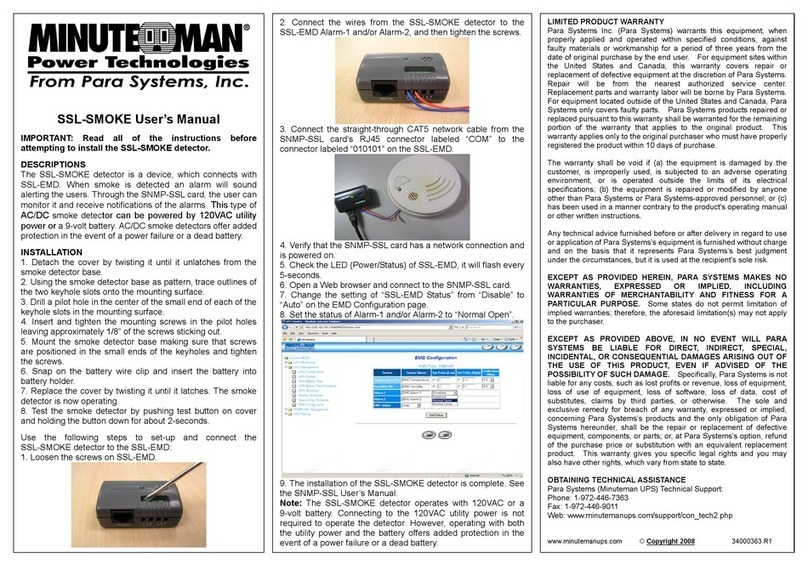
Para systems
Para systems MINUTEMAN SSL-SMOKE user manual
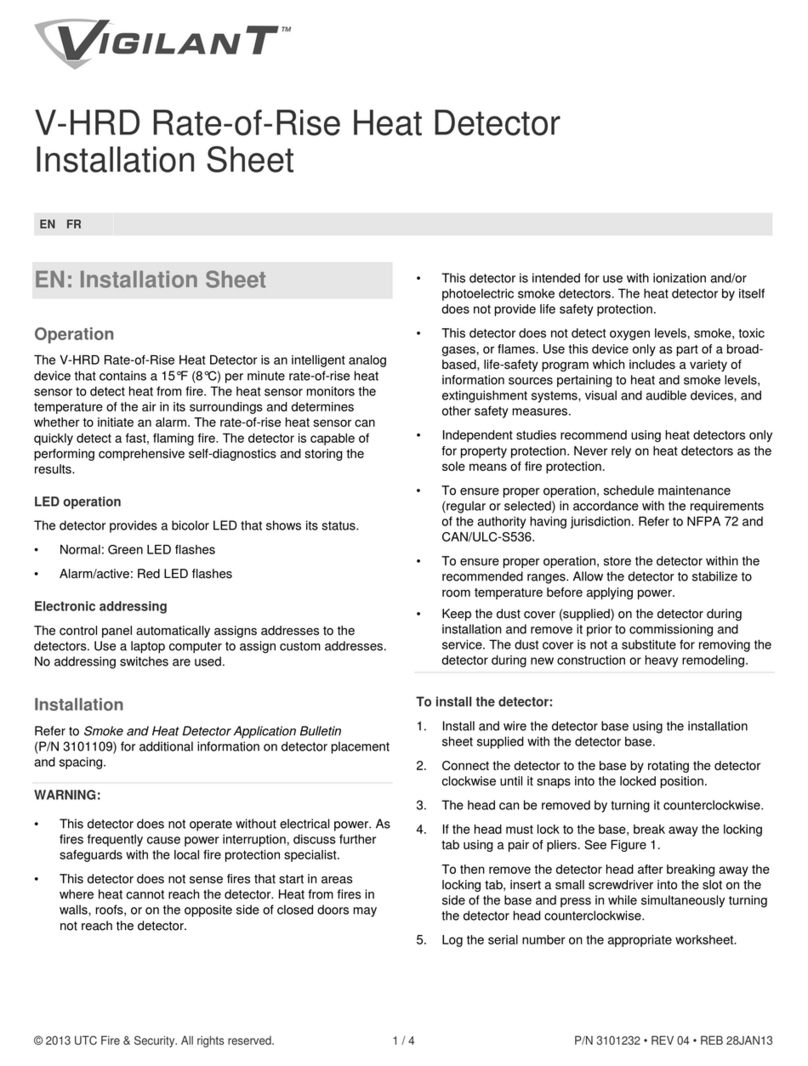
Vigilant
Vigilant V-HRD Installation sheet
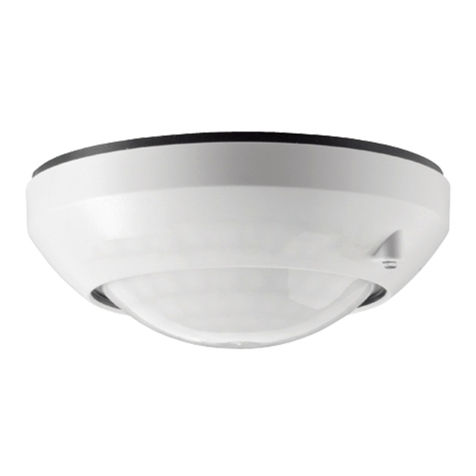
Jung
Jung FMDW360WW operating instructions
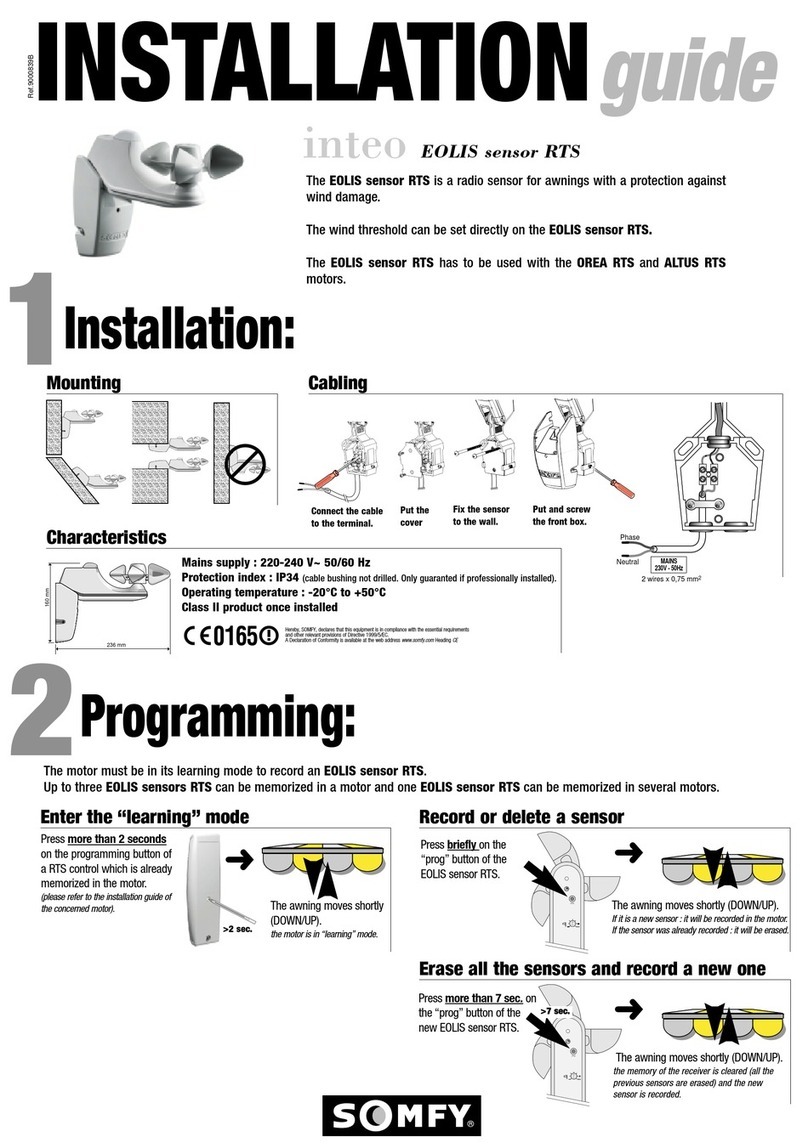
SOMFY
SOMFY inteo EOLIS sensor RTS installation guide
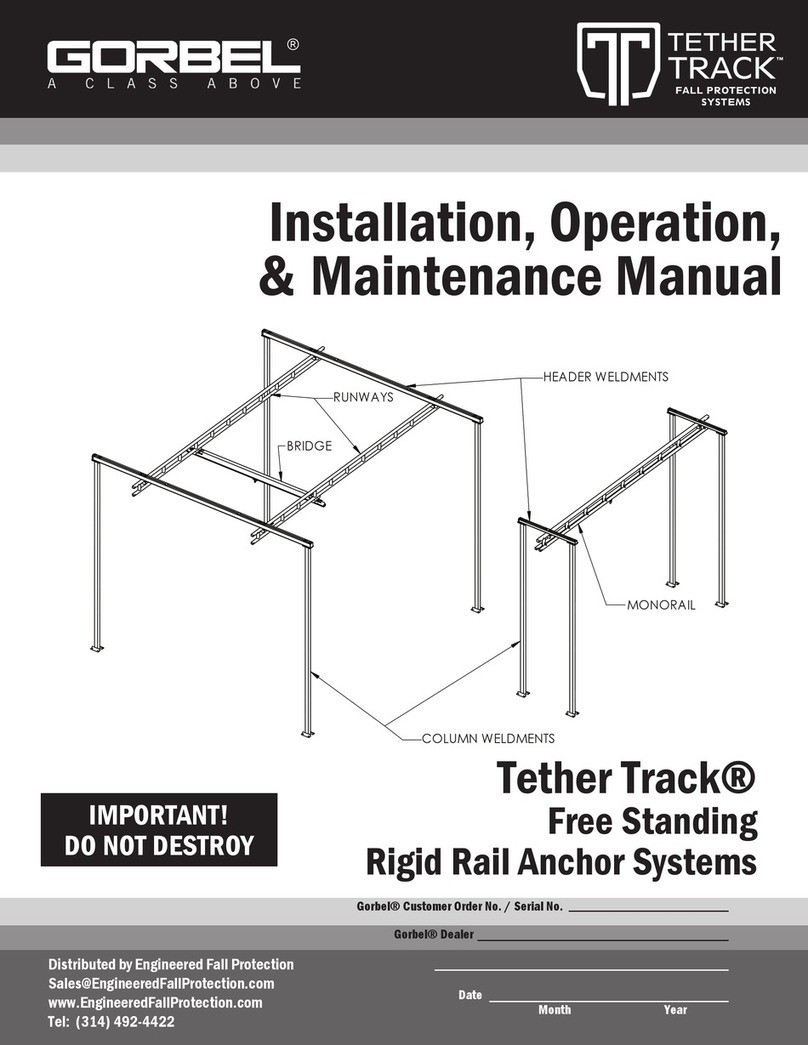
GORBEL
GORBEL Tether Track Installation, operation & maintenance manual
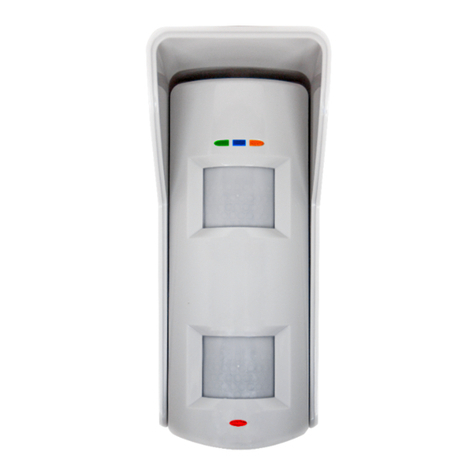
HIK VISION
HIK VISION DS-PD2-T10P-WEH manual

